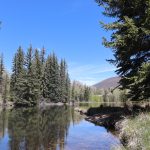Wolverines to make a big comeback in Colorado after governor signs re-introduction bill
Measure comes after years of lawmakers working to create a plan for bringing the animals back to Colorado
ewenzler@swiftcom.com and rspencer@summitdaily.com

Ryan Spencer/Summit Daily News
High above the tree line along Loveland Pass, a wolverine stood on a ridge line where one had not for at least a century before.
It was not a live wolverine but a stuffed one, brought along as a prop to Monday’s bill signing ceremony where Gov. Jared Polis put his signature on a bill allowing the re-introduction of the species that was eradicated from the state in 1919.
Above 12,000 feet, the choice of location was somewhat inhospitable for a press conference. Snow still blanketed the terrain, and a fierce wind at one point blew over the table where the governor later sat to sign Senate Bill 174.
Yet, this harsh high Alpine terrain was once native habitat for wolverines.
“Colorado has great high mountain country that is perfect for wolverines,” Polis said. “They’re very shy, solitary animals, hardly anyone is ever going to see one, but they play an important role as scavengers in the ecosystem.”
The measure allowing the re-introduction comes after years of lawmakers working to create a plan for bringing the animals back to Colorado. Wolverines, once native to Colorado, were eradicated from the state more than a century ago.
The bill comes just months after the start of the controversial, voter-approved wolf re-introduction. Sponsors of the wolverine legislation, including Sens. Perry Will and Dylan Roberts, have been vocal critics of the wolf re-introduction process, calling their own approach instead the right way to introduce a species.
Some Republicans in the Legislature opposed the wolverine efforts, saying their communities were still scarred by the last predator re-introduction.
Polis said that re-introduction efforts are aimed at restoring Colorado to the ecological balance it knew for millennia.
“It’s all about balance, and nature has a wonderful balance,” Polis said. “Of course, humans are part of living in our great state, but in the past, humans have driven a few species out and to extinction in our state. And now, we’re really making sure we can go back and co-exist and have a healthy ecosystem and wildlife.”

What do we know about wolverines?
Wolverines, known for being “small but fierce” may partially share a name with wolves, but they’re actually weasels and are more often compared to bears. They have partially retractable claws that are about 4 inches. That’s compared to black bears, which have claws smaller than 2 inches.
While they are sometimes opportunistic hunters, occasionally taking down animals as big as deer, wolverines are mostly scavengers. They will typically find carcasses to gnaw on or small animals such as rodents, rabbits, and marmots to fill their belly.
Will wolverines threaten humans?
Because wolverines live above the timberline, between 10,000 and 12,000 feet above sea level, there isn’t expected to be much interaction with humans, said Joey Livingston with Colorado Parks and Wildlife (CPW).
They’re also naturally a low-density population, with a single animal roaming a huge territory up to 500 square miles. The males are known to viciously protect their areas by killing other wolverines competing for food in their territory, including mothers and their young.
Colorado, which has some of the largest areas for wolverine population, could only support a maximum of up to 180 of the animals. There are only about 400 of the animals in the contiguous U.S.
Hunters who have killed an animal in the high country are more likely to have an interaction with a wolverine looking for a food source. Anyone who does see a wolverine should give it space and not attempt to scare it away from a carcass, Livingston said.
“Wolverines have the reputation for being very fierce,” he said.
What about livestock kills?
CPW isn’t expecting to see much, if any, attacks on livestock, Livingston said. In the past 50 years, the agency could only find evidence of two wolverine attacks on livestock in the U.S.
There will be a compensation plan in place to pay any rancher as needed in the case of a livestock kill, he said.
When and where will reintroduction happen?
Unlike the wolf re-introduction, the plan to bring wolverines back to Colorado doesn’t have a set timeline. The minimum is at least a year and a half to two years — that’s how long the U.S. Fish and Wildlife Service is expected to decide whether to designate the population under its 10(j) rule, which allows the state more flexibility in managing the animals.
The state won’t begin re-introduction until that designation, which was also a key element in the wolf re-introduction process, is granted, Livingston said.
CPW will also continue to develop their re-introduction plan, including where to get the animals and where to release them. Initial release zones being considered are throughout the Western Slope.
CPW’s preliminary plan is to release 30 wolverines over two years or 45 wolverines over three years, with a two-to-one female-to-male ratio, Livingston said. The animals would need to be released in different areas to avoid conflicts between them.
Preps: Five AHS athletes celebrated, girls golf finishes fourth at state
The season came to an end Tuesday for the Aspen High School girls golf team, which finished fourth after the final day of the 3A state championships in Loveland.









